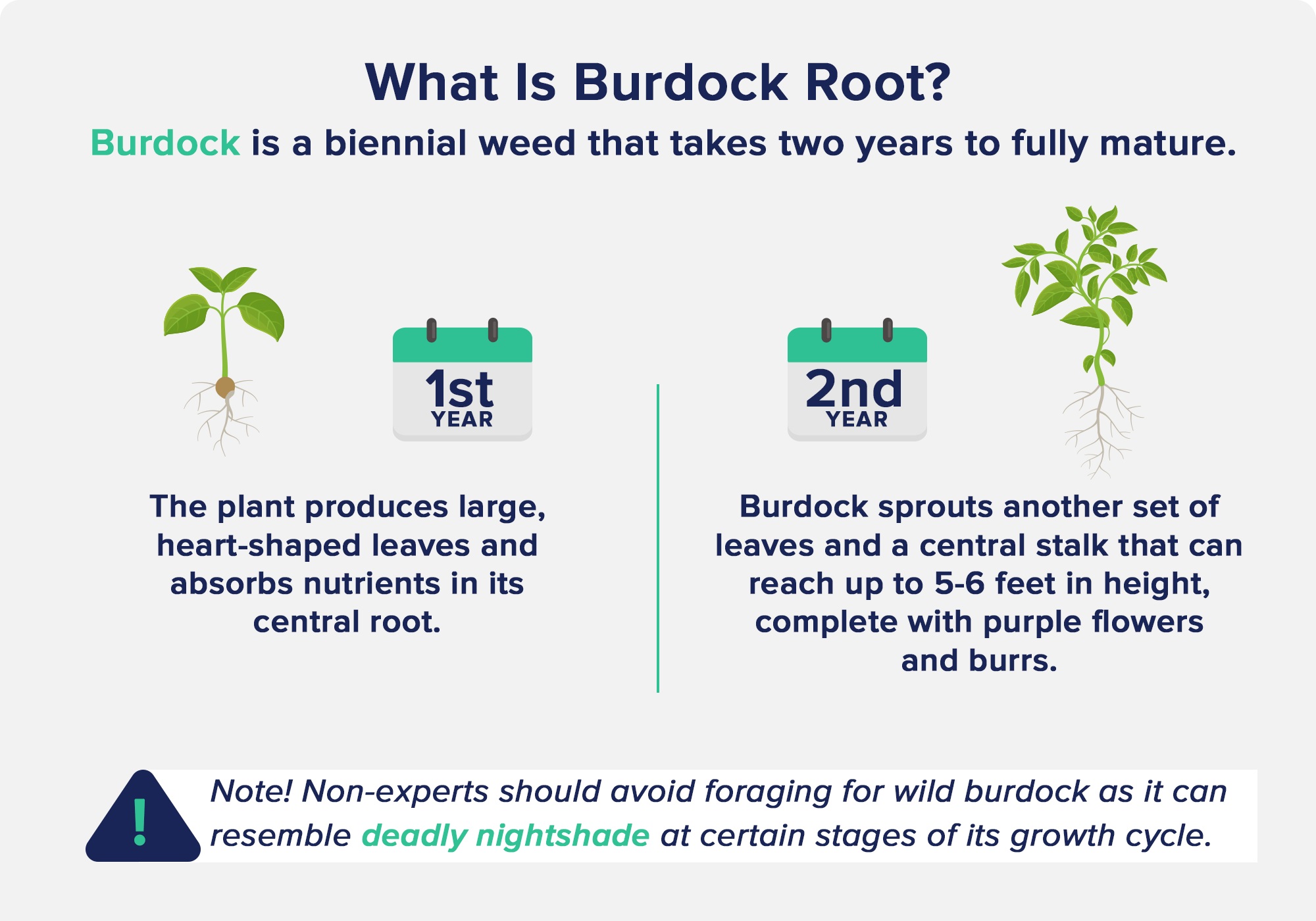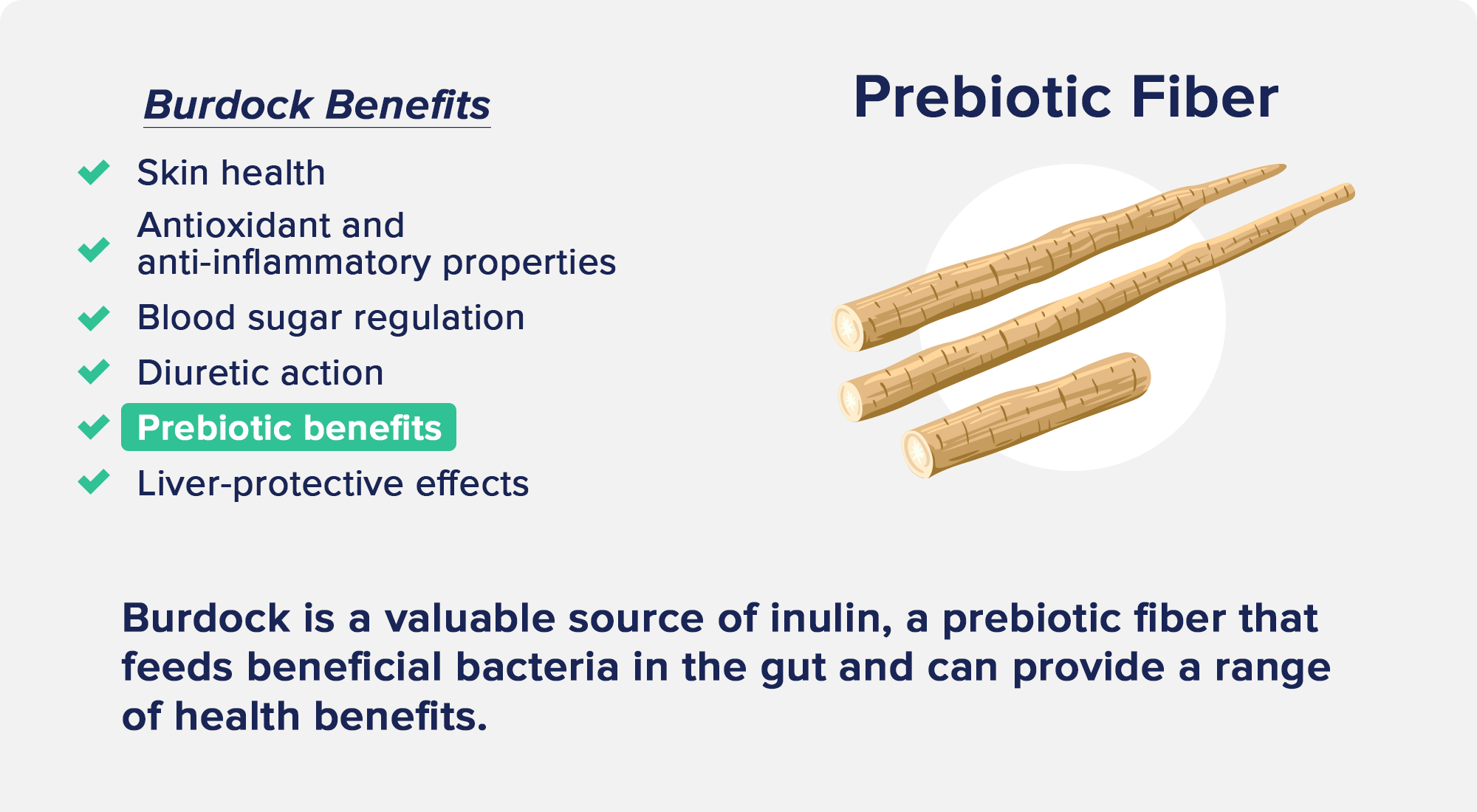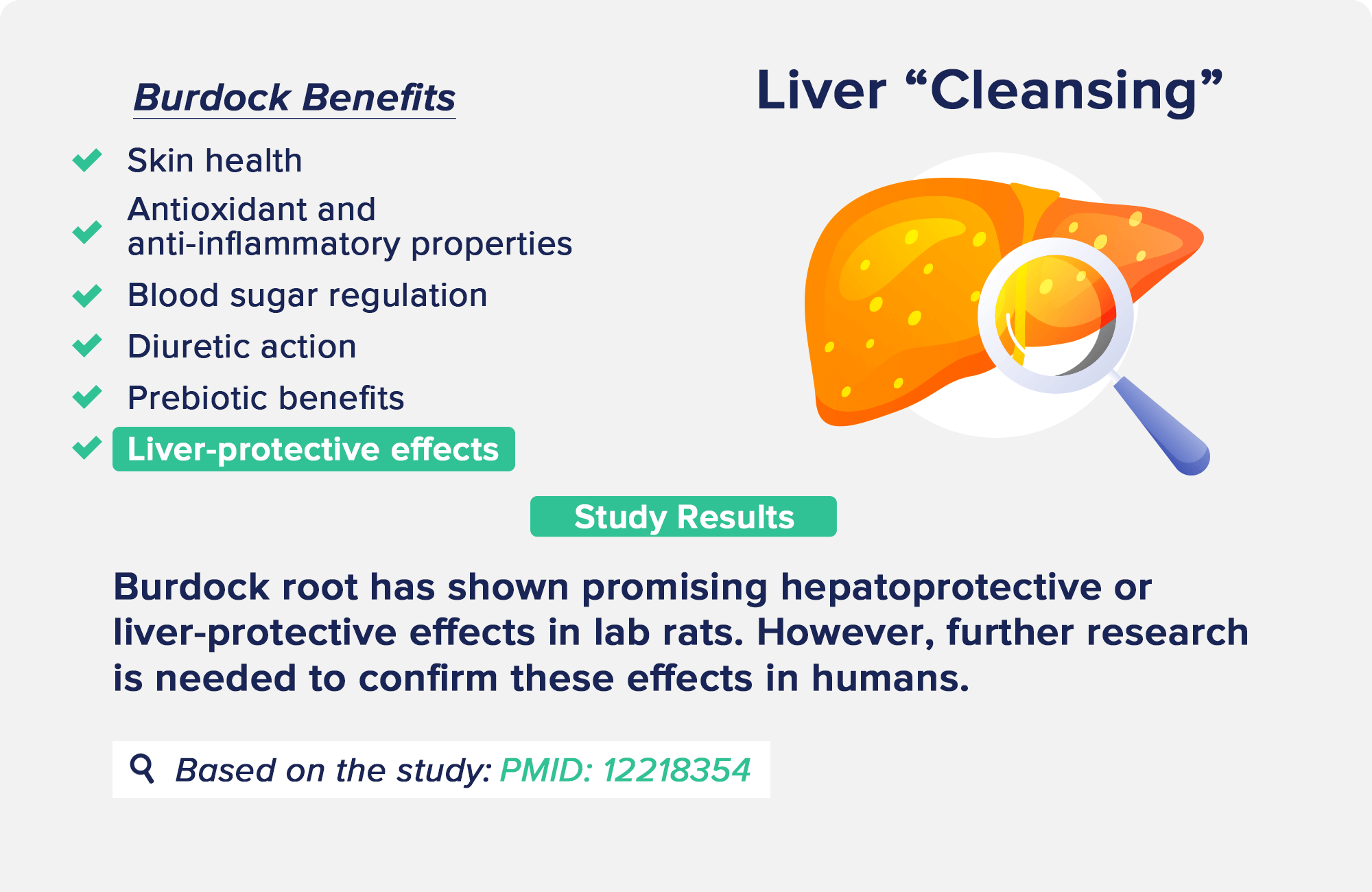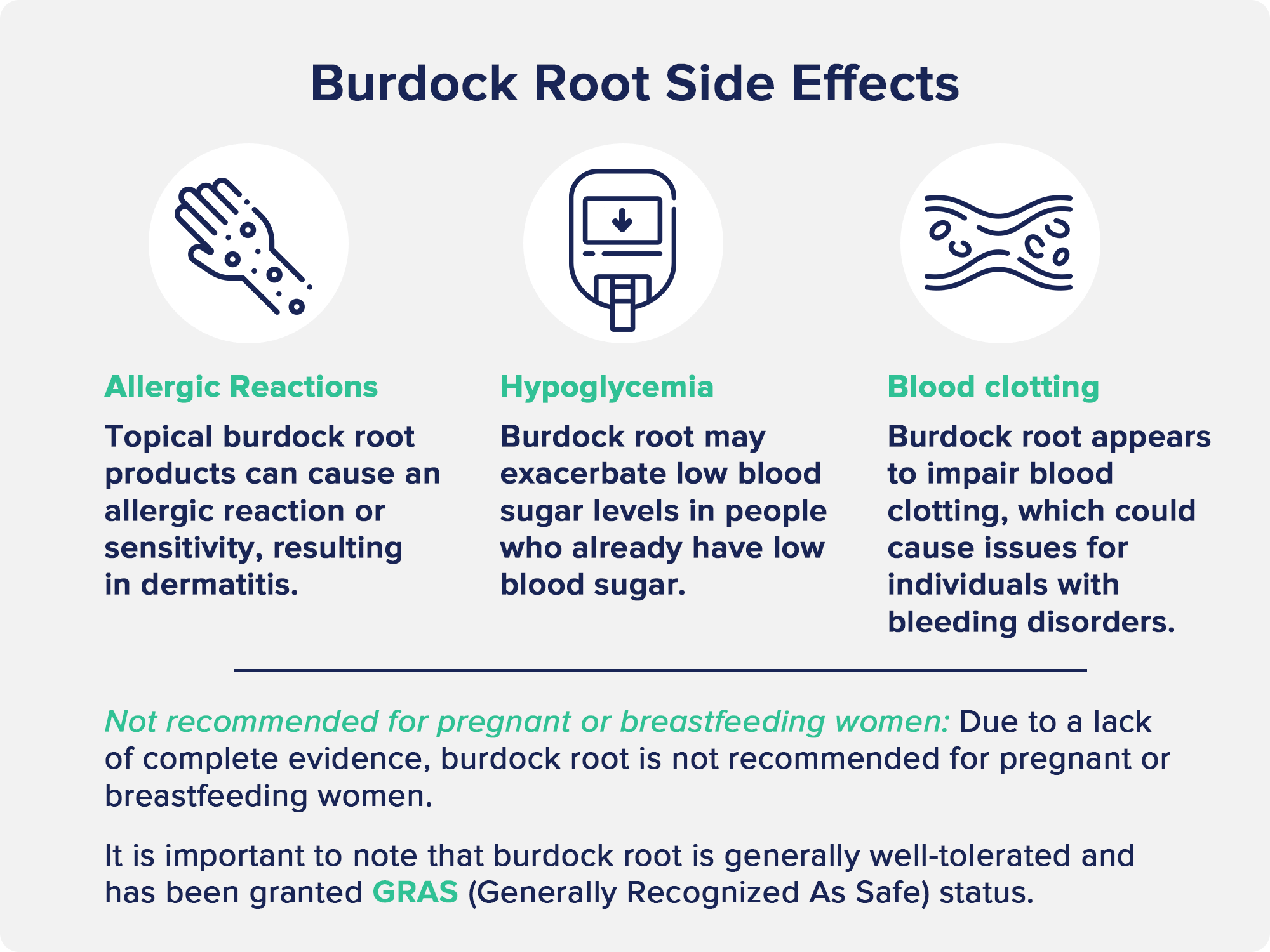Try our favorite, clean protein powder: See our top pick →
Try our favorite, clean protein powder: See our top pick →
This post contains links through which we may earn a small commission should you make a purchase from a brand. This in no way affects our ability to objectively critique the products and brands we review.
Evidence Based Research To fulfill our commitment to bringing our audience accurate and insightful content, our expert writers and medical reviewers rely on carefully curated research.
Read Our Editorial Policy
It may look like a simple weed from the ground up, but a firm yank on the green stalks of burdock (check for burrs first!) reveals a surprise.
This starchy, highly nutritious root was likely as valuable to a hungry forager as it has been to traditional Eastern medicine, where it’s touted as a blood purifier, skin healer, and more.
The Japanese, who dubbed it “gobo,” were also fond of this medicinal thistle for its various health benefits.
In this guide to all things burdock root, we’ll cover a comprehensive introduction to the plant, research-supported uses, and some tips on where to find and how to use this handy root.
Burdock, or Arctium lappa L., is a biennial weed, meaning it takes two years to fully mature.

During year one, the plant produces large, heart-shaped leaves while absorbing nutrients in its central root.
The next year, after the leaves die off, burdock sprouts another set of leaves, along with a central stalk that can shoot up as high as 5-6 feet (complete with purple flowers and burrs at the end of year 2).
Both geographically and functionally, burdock is a bit all over the place. It is native to Europe and Asia, and is now found in the United States, Canada, New Zealand, and Japan.
The root is intentionally cultivated in all of these countries, but not so much in the United States, where it mostly volunteers as a weed, but some forage for it.
On this note, we strongly discourage non-experts from foraging for wild burdock, as it can strongly resemble deadly nightshade (Atropa belladonna) depending on which stage of the growth cycle you find it in.
Because burdock root is versatile—having applications in cosmetics (oils, shampoos), cooking, burdock root tea, and supplements—where you might find it depends on the kind of preparation you’re looking for.
Solaray and Mountain Rose Herbs are our two top picks for organic, high-quality burdock root supplements, which come in capsule form in these instances.
Some major grocery stores (Whole Foods, for example) sell burdock root, and you might find whole, fresh burdock root at your local mom-and-pop health food stores and farmers’ markets.
If you manage to find whole burdock root, it’s fairly easy to cook with: peel, slice, and roast with oil and seasonings.
Applications of burdock root, as claimed by traditional Eastern medicine proponents, include treatment of pneumonia, fever, cough, sore, measles, eczema, constipation, and several other uses.
Contemporary (and contemporary-ish) research is beginning to color in this outline with studies confirming some of these benefits, but compared to most popular root vegetables, the overall data on burdock is still quite sparse.
Still, the current consensus has managed to demonstrate a handful of burdock root benefits/applications on human as well as animal (usually rodent) participants, including the following:
Let’s start from the top, which is one of the most well-evidenced and widely promoted benefits of burdock: skin health.
In this finding conducted jointly by several Korean universities, a burdock root extract was shown to suppress the secretion of pro-inflammatory compounds (namely, interleukin 4 and interleukin 5).
Citing this and several other anti-inflammatory mechanisms that are particularly well-applied to inflammatory skin reactions, the authors concluded that burdock root may be useful for the treatment of atopic dermatitis.

Expanding on the anti-inflammatory applications of burdock root, researchers from Tabriz University in Iran demonstrated a potent reduction in certain inflammation indicators—high sensitivity C-reactive protein and interleukin-6—among knee osteoarthritis patients given burdock root.
The participants, who received a total of 6 grams of burdock root each day over a 42-day study period, also showed a statistically significant increase in “total antioxidants capacity.”
A “free radical scavenging” ability of burdock has also been confirmed in studies, including this finding that demonstrated burdock’s antioxidant activity in rats.

Mice with type 2 diabetes demonstrated an increase in insulin production after receiving 200 mg/kg doses of burdock root extract, per this study from Iranian diabetes researchers.
Importantly, the researchers note that not all dose sizes allowed for this “insulinotropic” benefit, and that the lipid-lowering effect of burdock root helped treat the diabetes also.

Whether or not this is a benefit or a bane is purely situational, but when used intentionally as a natural diuretic, burdock root has proven to serve the role well.
Diuretics are substances that increase the frequency and/or volume of urination by prompting the kidneys to release more water, which has many clinical applications.
For example, diuretics are often used to treat high blood pressure, edema (swelling), congestive heart failure, and other issues.
The advantage of burdock root in this context is that it is a well-tolerated, natural option.
Of course, in more urgent cases, it’s not likely that you’ll be replacing the potency of a prescription-strength diuretic or “water pill.”

Burdock is very rich in inulin, a prebiotic fiber that comes with a list of potential benefits.
Prebiotics are foods that “feed” the benevolent bacteria in our stomach, which in turn facilitate digestion of certain foods, immunity, and even mood, to an extent.
This article illuminates several other key benefits of inulin, which has received GRAS (generally recognized as safe) status from the FDA, including, but not limited to:
Fiber in general is increasingly overlooked in modern food systems that fill grocery store shelves with cheap, processed options. As our breakdown on the fiber gap explains, fiber is essential for heart health, digestion, and much more.

Finally, the “hepatoprotective” or liver-protective effects of burdock root are very clinically relevant, as this Taipei Medical University trial demonstrated.
In rats, 300 mg/kg of burdock root administered 3 times a day “significantly improved various pathological and biochemical parameters which were worsened by ethanol plus carbon-tetrachloride-induced liver damage.”
In other words, burdock root partially reversed liver damage in lab rats, an effect gauged by the measurement of triglyceride levels, liver enzymes, and other key markers of liver health.

The nature and probability of side effects in the case of burdock usage depends heavily on the form (concentrated supplement versus fresh burdock) and application.
Though topical burdock root products (creams, lotions, etc.) have been shown to help with dermatitis, there’s still a chance that some people may have an allergy or sensitivity to it, which can actually result in dermatitis.
Along similar lines, the hypoglycemic effect of burdock root is great for diabetics, but could have exacerbating effects on people with already low blood sugar.
One line of evidence points to the possibility that burdock appears to impair blood clotting, which is of course not desirable for people with bleeding disorders, post-surgical patients, and others who may experience significant bleeding.
As we so often hear, burdock root is not recommended for breastfeeding or pregnant women because the evidence is not yet complete enough to rule out any issues in this context.
Otherwise, burdock root is generally very well tolerated, hence its GRAS status.

While precise burdock dosage guidelines have not yet been established by clinical researchers, the majority of trials on both humans and animal participants involve daily administration of burdock supplements or other preparations, with few adverse events reported.
This combined with its GRAS (generally recognized as safe status) strongly suggests that burdock is safe to use every day.
Keep in mind, this doesn’t guarantee that you can safely take it every day for long periods of time, or that higher dosages won’t cause any adverse effects.
The definition of “cleanse” may vary slightly from person to person, but there’s strong evidence suggesting that burdock has hepatoprotective effects at specific doses.
It has been shown to partially, but significantly reverse the effects of liver damage in rats.
Burdock root is generally recognized as safe by the FDA, but still, side effects can happen.
The nature, likelihood, and potency of these effects can vary based on the form/concentration of burdock used.
Here’s a summary of the most common burdock side effects as detailed in an above section:
– Allergic reactions, dermatitis (topical burdock products)
– Hypoglycemia
– Impaired blood clotting
If you have reactive skin, diabetes, low blood sugar, or a bleeding disorder, consulting with a physician is recommended before using a burdock supplement.
Pregnant and breastfeeding women should also do so, along with anyone taking a blood thinner.
As of yet, there isn’t a long list of “hard contraindications” (people who definitely shouldn’t use burdock), but this isn’t to say that burdock is safe for everyone—it means more safety data is needed.
At this point, the research data suggests that people with reactive skin, low blood sugar, bleeding disorders, or a recent surgery should proceed with caution, consulting with a healthcare professional and/or avoiding burdock altogether.
Burdock is a biennial weed native to Europe and Asia that forms a starchy, nutritious root.
Burdock has now been spread to and popularized in many countries, and is available both in supplement form and as a cooking ingredient (or tea).
You can cook with burdock, make tea with it, or use it as a topical product, but it’s highly discouraged that non-experts try foraging for it, as it resembles deadly nightshade.
The scientific consensus is thin, but positive when it comes to a list of potential burdock root benefits, which includes type 2 diabetes management, skin care, liver-protective effects, inflammation and antioxidant action, and more.
Subscribe now and never miss anything about the topics important to you and your health.